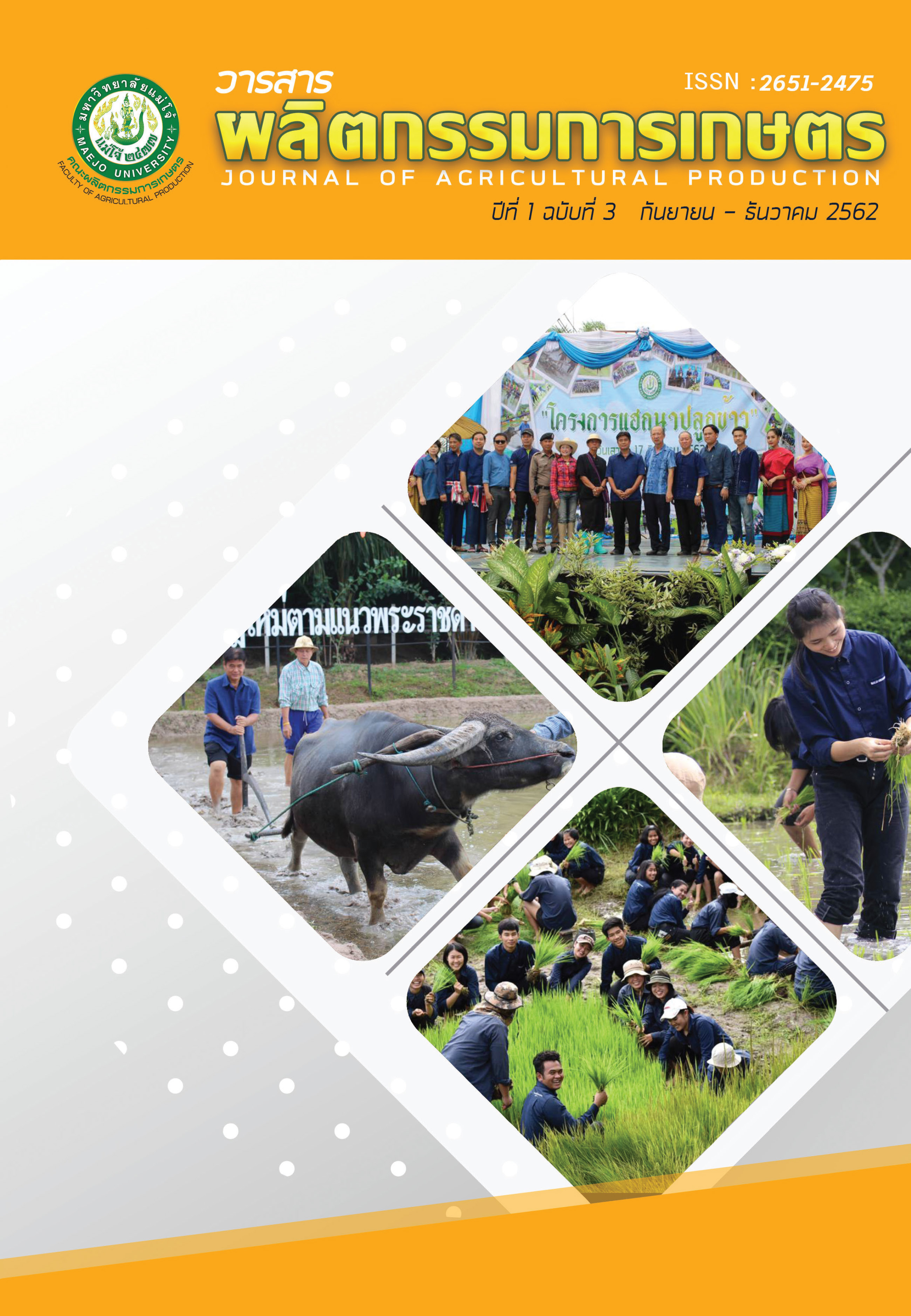ผลของเชื้อราอาบัสคูลาร์ไมคอไรซ่าที่มีต่อการเจริญเติบโตและ ผลผลิตมันฝรั่งหัวพันธุ์หลัก (G0) พันธุ์แอตแลนติก
Main Article Content
บทคัดย่อ
งานวิจัยนี้มีวัตถุประสงค์เพื่อศึกษาผลของเชื้อราอาบัสคูลาร์ไมคอไรซ่าต่อการเจริญเติบโตและ ผลผลิตของมันฝรั่ง G0 พันธุ์ Atlantic ในโรงเรือนกันแมลงของศูนย์วิจัยและพัฒนาการเกษตรเชียงใหม่ ตำบลโป่งนํ้าร้อน อำเภอฝาง จังหวัดเชียงใหม่ ระหว่างเดือนมกราคม-มีนาคม พ.ศ. 2562 โดยวางแผน การทดลองแบบสุ่มในบล็อกสมบูรณ์ (RCBD) ประกอบด้วย 6 กรรมวิธี 4 ซํ้า ได้แก่ การผสมเชื้อราอาบัส คูลาร์ไมคอไรซ่าปริมาณ 0, 1, 2, 3, 4 และ 5 กรัมต่อวัสดุปลูก 1 กิโลกรัม ก่อนนำไปปลูกหัวพันธุ์มันฝรั่ง G0 พบว่า ความสูงต้น จำนวนกิ่งแขนง และขนาดทรงพุ่ม เมื่อมันฝรั่งอายุ 60 วันหลังปลูก ในทุกกรรมวิธี ไม่มีความแตกต่างกันทางสถิติ ส่วนความยาวราก พบว่า การใส่เชื้อราอาบัสคูลาร์ไมคอไรซ่าปริมาณ 5 กรัมต่อวัสดุปลูก 1 กิโลกรัม ต้นมันฝรั่งมีความยาวรากมากที่สุด คือ 31.13 เซนติเมตร สำหรับข้อมูล ทางด้านผลผลิตของมันฝรั่ง G0 ที่อายุ 90 วัน พบว่า นํ้าหนักต่อหัว เส้นผ่าศูนย์กลางหัว นํ้าหนักหัวต่อต้น และความแน่นเนื้อ ในทุกกรรมวิธีไม่มีความแตกต่างกันทางสถิติ ส่วนจำนวนหัวต่อต้น พบว่า การใส่เชื้อ ราอาบัสคูลาร์ไมคอไรซ่าปริมาณ 3, 4 และ 5 กรัมต่อวัสดุปลูก 1 กิโลกรัม มีจำนวนหัวมากที่สุด คือ 3.88, 3.50 และ 3.62 หัว ตามลำดับ อย่างไรก็ตาม การปลูกมันฝรั่งโดยไม่ใส่เชื้อราอาบัสคูลาร์ไมคอไรซ่าเลย พบว่ามีจำนวนหัวน้อยที่สุด คือ 2.13 หัว
Article Details

อนุญาตภายใต้เงื่อนไข Creative Commons Attribution-NonCommercial-NoDerivatives 4.0 International License.
เอกสารอ้างอิง
สำนักส่งเสริมและจัดการสินค้าเกษตร. 2562. มันฝรั่ง. แหล่งข้อมูล http://www.agriman.doae.go.th/home/news/2562/49-50.pdf (29 สิงหาคม 2562).
Chen, B.D., X.L. Li, H.Q. Tao, P. Christie and M.H. Wong. 2003 The role of arbuscular mycorrhiza in zinc uptake by red clover growing in a calcareous soil spiked with various quantities of zinc. Chemosphere. 50(6): 839-846.
Gallou, A., H.P.L. Mosquera, S. Cranenbrouck, J.P. Suarez and S. Declerck. 2011. Mycorrhiza induced resistance in potato plantlets challenged by Phytophthora infestans. Physiol. Mol. Pl. Pathol. 76: 20-27.
Graham, S.O., N.E. Green and J.W. Hendrix. 1976. The influence of vesicular–arbuscular mycorrhizae on growth and tuberization of potatoes. Mycologia. 68: 925-929.
Lone, R., R. Shuab, V. Sharma, V. Kumar, R. Mir and K.K. Koul. 2015. Effect of arbuscular mycorrhizal fungi on growth and development of potato (Solanum tuberosum) plant. Asian J. Crop Sci. 7(3): 233-243.
Marschner, H. and B. Dell. 1994. Nutrient uptake in mycorrhizal symbiosis. Plant Soil. 159: 89-102.
McArthur, D.A.J. and N.R. Knowles. 1993. Influence of species of vesicular arbuscular mycorrhizal fungi and phosphorus nutrition on growth, development, and mineral nutrition of potato (Solanum tuberosum L.). Plant Physiol. 102: 771-782.
Vosatka, M. and M. Gryndler. 2000. Response of micropropagated potatoes rans planted to peat media to post-vitro inoculation with arbuscular mycorrhizal fungi and soil. Appl. Soil Ecol. 15: 145-152.
Yao, M.K., R.J. Tweddell and H. Desilets. 2002. Effect of two vesicular-arbuscular mycorrhizal fungi on the growth of micropropagated potato plantlets and on the extent of disease caused by Rhizoctonia solani. Mycorrhiza. 12: 235-242.


